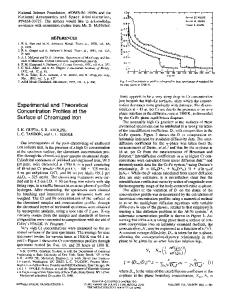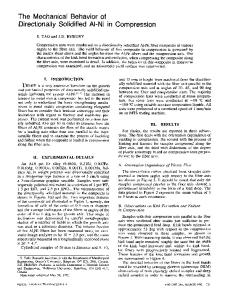On the Characterization of Directionally Solidified Dendritic Microstructures
- PDF / 1,006,263 Bytes
- 9 Pages / 593.972 x 792 pts Page_size
- 8 Downloads / 285 Views
TRODUCTION
THE microstructure of a material is rarely homogeneous or entirely regular. Instead, spatial distributions of microstructural features are usually present, e.g., bimodal grain structures, precipitates of varying dimensions, and defects such as pores or microcracks. This situation should be acknowledged more widely in the field of materials. Why? Because although the mean size of any microstructural feature is of considerable importance, the material’s behavior is often controlled by statistical deviations from the mean values observed. For example, fracture behavior is controlled usually by the largest rather than the mean defect size. A variation in fatigue performance is linked intimately to the standard deviation in the grain size. And for bimodal distributions, cavitation damage arising from creep deformation is found often to be greater at the grain boundaries of the smaller grains. This article is written with the previous description in mind. A method is presented for the stereological assessment of arrays of dendrites of the type arising during directional solidification. In particular, it allows spatial distributions of dendrite arm spacings to be estimated. It should be noted that this article deals strictly with directionally solidified structuress, the primary length scale of equiaxed structures is defined by the grain size. Characterization of the microstructure of directionally solidified dendritic arrays is important because (1) its scale determines the extent of microsegregation and interdenNILS WARNKEN, Research Fellow, and ROGER C. REED, Professor, are with the Department of Metallurgy and Materials, University of Birmingham, Edgaston B15 2TT, UK. Contact e-mail: [email protected]. Manuscript submitted May 11, 2010. Article published online December 16, 2010 METALLURGICAL AND MATERIALS TRANSACTIONS A
dritic porosity, and the details of the subsequent processing needed to remove these[1,2]; (2) the propensity for processing-related defects such as freckling—caused by thermal-solutal convection currents—are influenced by it[3–5], and (3) the mechanical performance of many systems are influenced strongly by the scale and distribution of the dendritic structure inherited from processing.[6] In practice, the characterization of dendritic microstructures presents an additional difficulty as a result of their inherent anisotropy, because their morphologies are strongly inherited from the heat flow arising during freezing. Thus, the characterization of directionally solidified dendritic arrays makes an interesting and highly topical test case for new stereological assessment procedures of the type presented in this article. As will be discussed, the method presented has wider applicability, but in what follows we choose to apply it to the dendritic microstructures arising from the directional solidification of the nickel-based superalloys.[7] These find widespread application in the hottest sections of the gas turbines, e.g., those used for jet engines and electricity generation.[8,9] When solidified in t
Data Loading...










